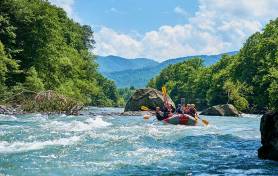

How To Stay Safe During Hot Weather Hiking
It’s the eternal Catch-22. The only time you have to go hiking is during the summer, but the summer is the hottest time of the year, making it potentially dangerous, wherever you are.
Videos by Outdoors
However, as with most dangers of the great outdoors, hot weather hiking is only as dangerous as you are unprepared. Here are some simple steps on staying safe during your hot weather hiking trips.
Bring More Than Enough Water
You should bring water on every hike, but if it’s a short hike or not too hot, you can get by with just a single water bottle and tough it out the last half hour back to the car. But if you’re hiking in hot weather, you’re going to go through water a lot faster than you think. In fact, you might not even notice how much water you’re losing if you’re in a high altitude or dry climate (or both).
Hot weather hiking is going to require you to be constantly, consciously hydrating. Typically you’ll want to drink a liter (about 33 fl oz) of water an hour, or roughly 1 cup of water every 15 minutes. Typically though, this should be broken into regular sips, as drinking large quantities of water at once can make you sick.
For long hikes, that’s going to mean a large capacity hydration pack, and possibly some sort of water filtration system if you’re not going to have immediate access to clean water.
Remember Your Electrolytes
It’s not just water that you’re losing when you sweat profusely, but also crucial electrolytes. It’s best to replenish them through salty snacks, which can provide complex carbs and often protein and help you sustain your energy levels in addition to replenishing your electrolyte levels.
While sugary drinks like Gatorade advertise the ability to replenish electrolytes, there are two downsides. First, sugar is a simple carb, meaning frequent spikes and drops in your energy level. Second, carrying the number of sports drink bottles (or even the mix) necessary to stay hydrated on a long hike will add significant weight.
Have The Right Gear (Including The Right Clothes)
Your energy and water requirements will be different during hot weather hiking than they might be during a cooler spring or fall hike. That means you may need to upgrade to a backpack or hydration pack with external pockets for snacks. Make sure you get one that fits well, and if you opt for a full backpack, get professionally fitted for one.
As far as clothing goes, you’ll need to make sure your shoes, socks, clothing, and undergarments are breathable and fit correctly. Blisters and chafing are even more likely in hot weather and can slow you down or present other dangers.
You’ll also want to be sure you’re packing sunscreen and a first aid kit.

Avoid High Sun
One of the keys to making hot weather hiking safer is to make it less of those things. The strongest direct sunlight is going to be in the hours before and after high noon (2-3 hours on either end, depending on your location and time of year), so if possible, start your hike early in the morning. Simultaneously, while it’s still cool, consider cutting it short to avoid extended exposure during those hours. Alternatively, plan a break during those hours. It can be for lunch, rest, sightseeing, or anything else, and return later than you otherwise would.
If you’re on an all-day hike, and being out during those times is unavoidable, consider planning a route that will have you out of direct sunlight during those times. At the very least, plan frequent breaks, and be especially conscious of your hydration during those times.
Have An Emergency Plan
Regardless of the weather, you should always have an emergency plan, but it’s especially important during high-risk times like hot weather hiking. Be sure to tell people where you’re going, and give them an estimated time when you’ll be back in contact. If you’re going to be out of touch for an extended period of time (one full day or more), be sure to have a way to contact emergency services. Carrying something like a ZOLEO Satellite Communicator could save your life.
Having an emergency plan also means being able to identify when there is an emergency. Please familiarize yourself with the symptoms and early warning signs of heatstroke and counter them before it becomes life-threatening.
In Conclusion
There’s no rule that says you have to stay inside when the weather is hot. With a little extra preparation and caution, even hot weather hiking can be rewarding (making the AC feel even better).









